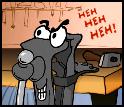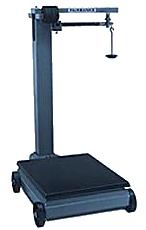|
|
| |
| |
| |
|
| |
|
| |
| |
| |
| |
| |
| |
| |
| |
| |
| |
| |
| |
|




|

Tell them you found it on anvilfire.com!

Blacksmithing and metalworking questions answered.
|

NIST, standards, weights, traceability, Fairbanks Scales, Ohaus, balance, weighing, poise, calibration
|
|

Scale calibration adjustment is relatively simple. Turn a screw or rotate a weight on a screw until the scale zeros and then you are done.
But commercial law requires that the scale be tested within its range and certified for use in commerce.
If you sell anything by the pound, ounce or kilogram then your scales must be certified by your local bureau of weights and measures.
The scale is then labeled "Certified for Trade".
In general the springless platform scales built by Fairbanks (the oldest scale company in North America) and others are durable and rarely do not perform acurately.
However, testing is usually done on an annual basis.
If you don't use your scale in commerce and just want to know if it is accurate then you can do your own testing.
Since I have numerous odd scales not used in commerce and one I am repairing I want to do my own testing.
Standard testing methods are as follows.
Parts paraphrase NIST (U.S. National Institute of Standards) and other documents.
The red is my added comments and suggestions.
- 1. Traceble Test Weights.
- All official and critical testing should be done with weights traceable to your country's Bureau of Standards and traceable to International standards.
Documentation should be on file and up to date.
Weights should be checked for condensation and dried if necessary.
For my purposes I purchased used undocumented weights on-line.
However, many of these had testing and certification marks and could be assumed to be fairly accurate (or had been) if not obviously worn or broken.
I also planned on testing these against each other and to the scales on hand.
This set of weights includes rectangular cast iron weights with integral handles in the sizes
100, 50, 20-a, 20-b, 10, and 5 pounds. This gives the capability to test up to 205 pounds in 5 lb increments.
I also purchased an antique set of brass balance weights in the sizes 4, 2, 1, 1/2 and 1/4 pounds and a NEW 2 oz (1/8th pound) weight.
- 2. Normalization
- For accurate testing the scale should be tested in the place and environment it will be used in.
A 24 hour normalizing period is recommended after moving and setting up a scale including any leveling.
While not stated in the standard methods the test weights should also be normalized in place.
However, this is rarely done. ~70°F (20°C) is the standard temperature for the use of virtually all precision devices.
- 3. ZERO
- The unloaded scale should be zeroed.
On scales with a poise hanger it should be in place and the correct hanger.
Often these hangers are a specific weight to counter balance the weight of the platform.
If after zeroing, the scale is off at the full beam scale with an equal calibration weight in place then the poise hanger may be at fault and require adjustment.
- 4.a Check Full Range
- Standard testing is done at 25%, 50%, 75% and 100% of full capacity.
The test weight is recorded and the measured value. Error is calculated in percent and recorded.
The worksheet with these values becomes the calibration test record or certification.
This should be signed and dated by the test operator.
If testing for yourself (non-commercial) and you do not have suitable weights to run the full range test then do what youy can.
Some writers recomend a mid range test OR testing at the most commonly used range with any object of known weight.
The first tests I ran on my 1000 pound Fairbanks was to zero, then weighed the additional counter poise (5, 2 and two 1 pound weights) which are more accurate than the scale could measure.
Even after purchasing hundreds of pounds of test weights I am far short of enough to run a full test on any of my larger fairbanks scales.
- 4.b Check at Full Beam and Zero
-
This double check is not an official test but will tell you if the scale and added poise are acurate in a limited range.
After zeroing the scale add test weights equal to the full beam marking and check with the sliding poise.
Then add a beam increment counter poise and check at zero with the same test weights.
This can be continued for as long as there are test weights up to full capacity.
- 4.c Sensitivity
At each calibration test point add a test weight equal to one half the smallest beam increment and then a test weight equal to the beam increment.
The half weights MAY or MAY NOT trip the beam and this is within the margin of error.
The full increment weights should be readable ever time they are added.
If not then the scale is worn (knife edges flattened) or there is some other issue.
- 5. Shift Test
- Scales of all types are the most acurate at the center of the platform.
As the load is shifted off center there may be errors in weighing.
Shift tests are done on larger scales using positions determined by the Bureau of Standards.
- About Poise and Testing
- The additive counter weights or poise are part of the scale's system and should be tested with the scale.
Some poise are even or multiples of even units (ounces, pounds, grams, kg).
These are used on scales with even multipliers.
Other poise are made in odd or fractional units to suit the range of the beam and scale multiplier.
These are specially made for the scale and can be hard to replace if lost.
When a 1 pound weight steps the scale up 100 pounds any error in the weight is multiplied 100 times.
Thus the counterweights must be very acurate (much more than the scale itself).
When a set of weights has duplicates each one should be used when testing.
Links
Platform Scales in the Shop
The International Society of Antique Scale Collectors (ISASC)
|
|
|



In general the springless platform scales built by Fairbanks (the oldest scale company in North America) and others are durable and rarely do not perform acurately. However, testing is usually done on an annual basis. If you don't use your scale in commerce and just want to know if it is accurate then you can do your own testing. Since I have numerous odd scales not used in commerce and one I am repairing I want to do my own testing.
Standard testing methods are as follows. Parts paraphrase NIST (U.S. National Institute of Standards) and other documents. The red is my added comments and suggestions.
When a 1 pound weight steps the scale up 100 pounds any error in the weight is multiplied 100 times. Thus the counterweights must be very acurate (much more than the scale itself). When a set of weights has duplicates each one should be used when testing.
Links
Platform Scales in the ShopThe International Society of Antique Scale Collectors (ISASC)